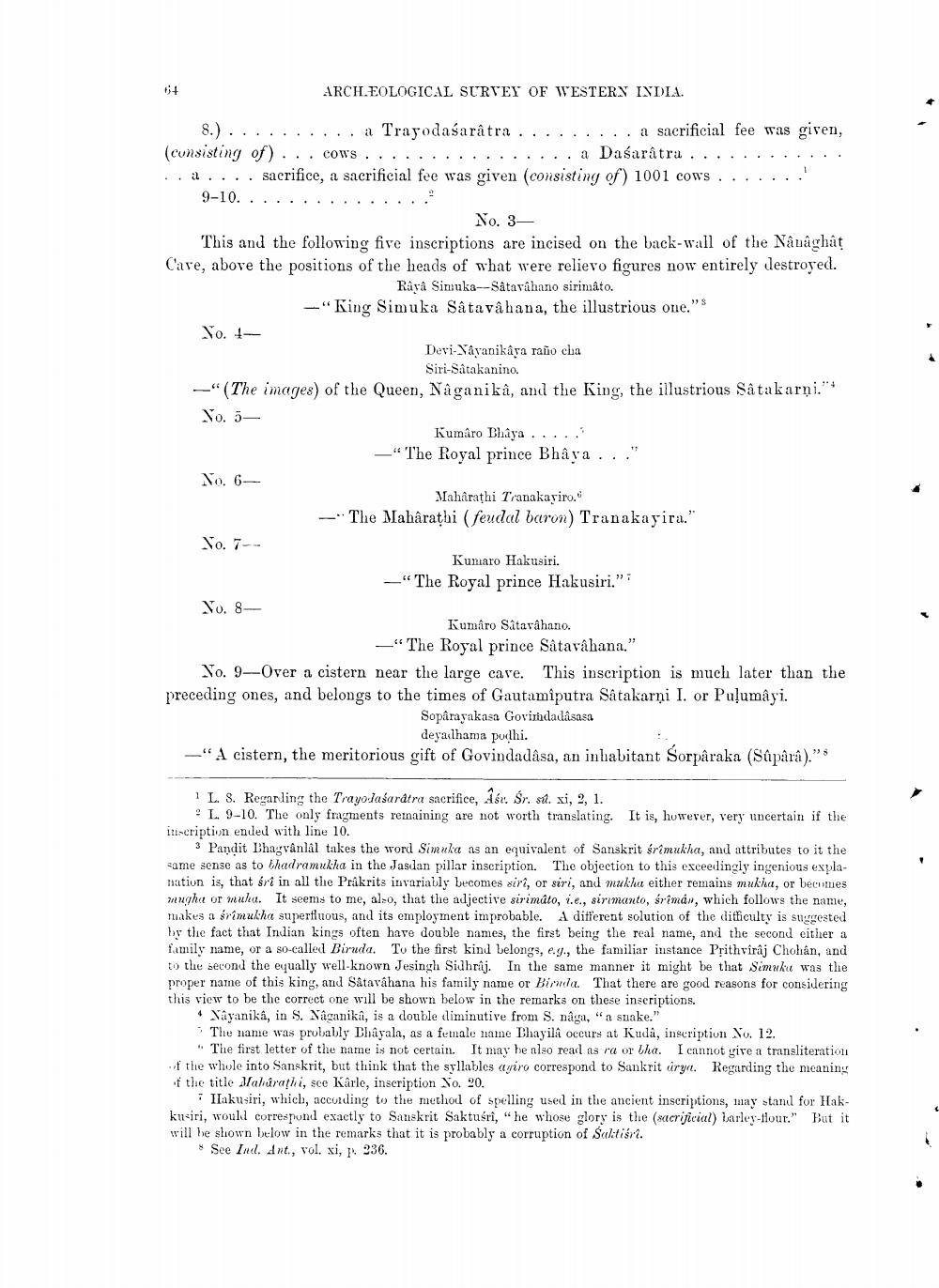________________
ARCHEOLOGICAL SURVEY OF WESTERN INDIA.
8.).......... a Trayodasarâtra ......... a sacrificial fee was given, (consisting of) ... cows ................ a Dasaratra... . .... sacrifice, a sacrificial fee was given (consisting of ) 1001 cows ....... 9-10...............
No. 3— This and the following five inscriptions are incised on the back-wall of the Nåvåghat Care, above the positions of the heads of what were relievo figures now entirely destroyed.
Råva Simuka--Satavahano sirimato.
-"King Simuka Sâta vâhana, the illustrious one." No. 4
Devi-Yavanikara raño cha
Siri-Satakanino. -"(The images) of the Queen, Naganikâ, and the King, the illustrious Satakarņi."* No. 5
Kumaro Dhaya .....
-" The Royal prince Bhava ..." No. 6
Mahârathi Tranakayiro. --The Mahârathi feudal baron) Tranakayira." No. 7--
Kumaro Hakusiri.
-"The Royal prince Hakusiri." No. 8
Kumaro Satavahano.
—“The Royal prince Satavahana." No. 9-Over a cistern near the large care. This inscription is much later than the preceding ones, and belongs to the times of Gautamiputra Satakarni I. or Puļumâyi.
Sopârayakasa Govindadasasa
deya hama pochi. -"A cistern, the meritorious gift of Govindadasa, an inhabitant Sorpâraka (Sâpârâ)."
1 L. S. Regarling the Trayodlašarátra sacrifice, śr. Śr. sú. xi, 2, 1.
L 9-10. The only fragments remaining are not worth translating. It is, however, very uncertain if the inscription ended with line 10.
3 Pandit Dhayvanlal takes the word Simuka as an equivalent of Sanskrit srimukha, and attributes to it the same sense as to bhadramukha in the Jasdan pillar inscription. The objection to this exceedingly ingenious explamation is that si in all the Prakrits invariably becomes siri, or siri, and mukha either remains mukha, or becomes mugha or muha. It seems to me, also, that the adjective sirimáto, i.e., sirimanto, sriman, which follows the name, makes a srimukha superfluous, and its employment improbable. A different solution of the difficulty is suggested by the fact that Indian kings often have double names, the first being the real name, and the second either a family name, or a so-called Biruda. To the first kind belongs, 2.9., the familiar instance Prithviraj Chohan, and to the second the equally well-known Jesingh Sidhrij. In the same manner it might be that Simuku was the proper name of this king, and Satavahana his family name or Birwa. That there are good reasons for considering this view to be the correct one will be shown below in the remarks on these inscriptions.
• Nayanika, in S. Någanika, is a double climinutive from S. någa, "a suake."
The name was probably Dhayala, as a female name Dhayilâ occurs at Kuda, inscription No. 12.
The first letter of the name is not certain. It may be also read as ra or tha. I cannot give a transliteration of the whole into Sanskrit, but think that the syllables ayiro correspond to Sankrit irya. Regarding the meaning of the title Mahürathi, see Karle, inscription No. 20.
Hakusiri, which, according to the method of spelling used in the ancient inscriptions, may stand for Hakkusiri, would correspond exactly to Sanskrit Saktusri, "he whose glory is the sacrificial) harley-Hour." But it will be shown below in the remarks that it is probably a corruption of Saktiér.
See Ind. Ant., vol. xi, 336.




